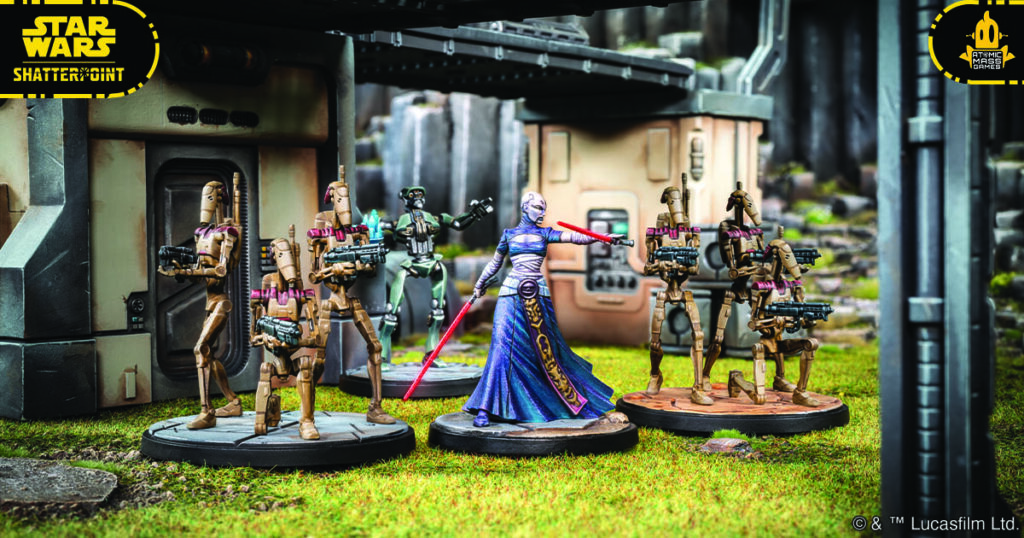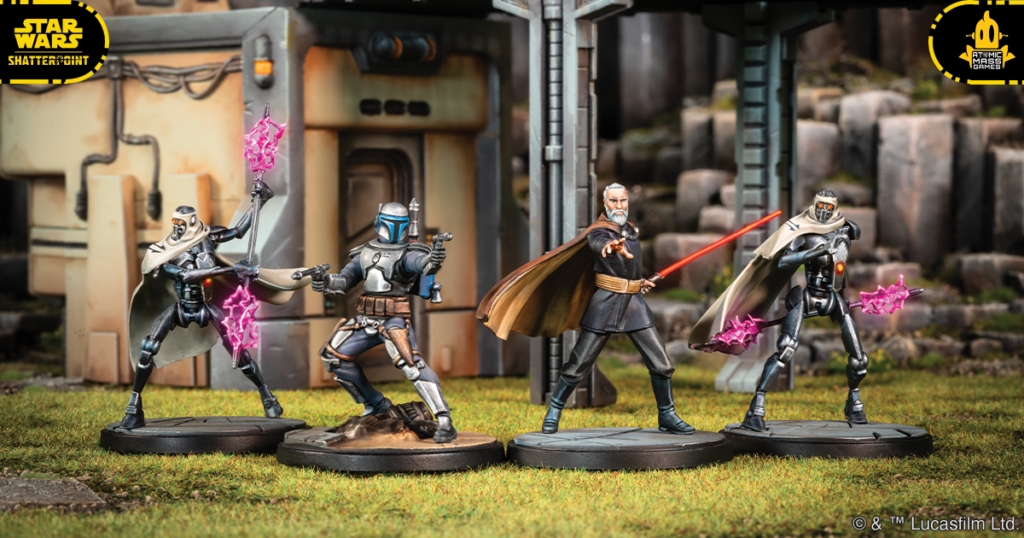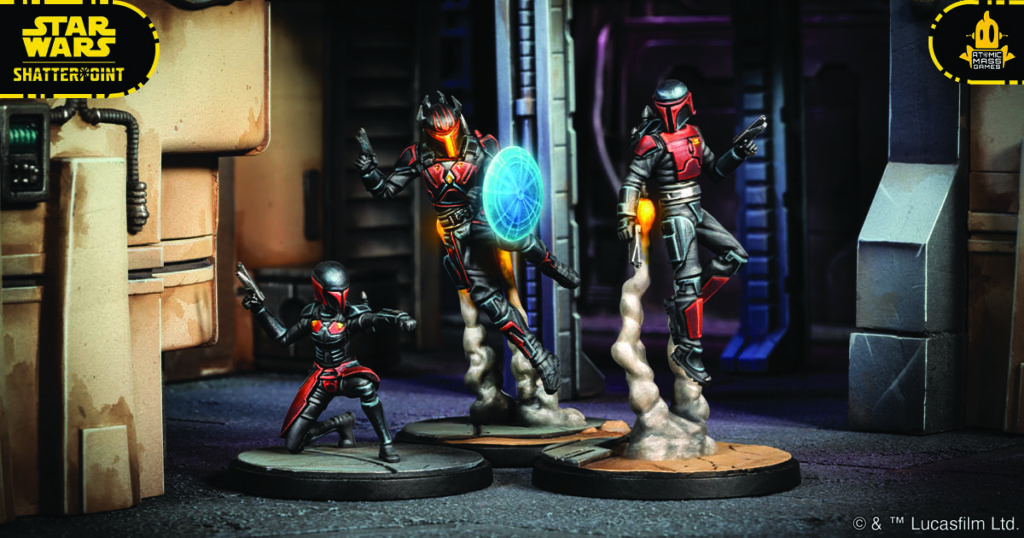Sculpting a Galaxy Far, Far, Away for STAR WARS™: Shatterpoint
02/06/2023In Star Wars: Shatterpoint, iconic characters from across the galaxy clash in this new miniatures skirmish game. Coming Summer 2023!

Today’s transmission is all about bringing the characters we know and love into stunning three dimensional reality. We rounded up Marco Segovia (Sculpting Director), Evan Kang (Engineering Manager), and Dallas Kemp (Creative Director) to answer questions about their experience working on the miniature sculpts for Shatterpoint.
Can you describe the Shatterpoint miniature aesthetic and how it was developed?
Dallas: The miniatures were designed to capture the action and adventure of the Star Wars universe. We had a real desire to see larger than life miniatures on the table.
Marco: It’s a stylized blend that pays homage to existing animated properties of Star Wars as well as the live action productions.
Evan: Between the live-action and animated media, we landed somewhere in the middle, maybe a bit more skewed in favor of the animated look. It’s certainly a challenging facet of design because these characters can be firmly planted in your head with a very specific appearance, so whenever there’s change you might say “something feels off!” By preserving specific landmarks or focal points in a sculpt, we can retain the essence of a character or object while establishing a different aesthetic. It’s an ever changing delicate balance.
Marco: We wanted to work with a 40mm scale in order to capture high resolution detail while providing large smooth areas for hobbyists to practice their blending and not clutter the aesthetics with noise. We wanted a balanced experience of detailed miniatures that provide even the most novice of painters a beautiful end result while also not being too busy with lots of elements and features that burns out the average painter. We want this to be an enjoyable experience and not a chore.
What role do miniatures play in bringing this type of game to life?
Dallas: Miniatures are the centerpiece to a miniatures game. Not only do they capture the personality of the characters, they bring the table to life when combined with the awesome terrain. They are also fun to paint and bring hours of entertainment and hobby time outside of the game itself.
Evan: The miniatures give a tangible element to connect with these characters and worlds. But also at face value, seeing a table filled with miniatures is just cool! There’s a unique level of excitement when interacting with physical objects, a sense of play that transmits from childhood. Is that cheesy? I can only speak for myself.
Marco: They allow people to bring in their own creativity to their games by customizing and building on top of what we offer in our line. The way we see miniatures is a collaborative art project with our community. Players can take what we’ve given them and either match what we’ve done with their own paint application or completely take it another direction by reposing and/or building a different vision of their miniature. It’s fun to create these miniatures but it’s rewarding to see a community’s creativity used to expand on our ideas to make something even greater for themselves.
How do you keep hobbyists in mind during the sculpting process?
Evan: The sculpting team always considers and prioritizes key points like build complexity, painting, and accessibility. This is another tricky balancing act because sometimes these aspects will directly conflict with each other instead of smoothly overlapping. The practicalities of physical production must always be considered in tandem with aesthetic design and every mini is a new puzzle for us to decipher. Working in miniature scale means we’re always exaggerating details in the sculpt. Usually that means enlarging fine detail and focusing on silhouettes, it can all be broken down to shape on shape. This works in favor of both assembling and painting the minis later on.
Marco: We constantly ask ourselves questions in balancing what different types of people want out of their miniatures. Is this easier to assemble? Is this tedious to paint? Does this look good from far away? Does the silhouette and shapes capture the attitude of the character? Can people look at this mini from a bird’s eye view and know who that is? What opportunities or stories are we providing when making optional pieces? The questions go on and never end.
Dallas: We try to minimize difficult or cluttered areas, create tight lines, and give space for painters to breath. We want to allow the highest degree of success when painting the miniature no matter the skill level.

What are the steps in the design process of sculpting a miniature?
Dallas: We start with a product pitch. That leads to a concept for the mini, which means a pose is created.
Evan: We start with a concept sketch to determine a pose that conveys the personality or actions of a particular character. Production needs are also considered at this stage in tandem with the creative composition.
Marco: Before we even begin sculpting, we also have to recognize the material we’re working in, recognize the limitations, and solve how we can creatively overcome them and give players what they want. A lot of front end work that will save you a lot of work down the road. Making a miniature helps in the art sense of understanding what are the details that are most important and not “getting lost in the sauce”. Do I really need to spend hours on making the best eye lid wrinkles even though it won’t read in the final result at miniature scale? The answer is no. No one remembers Anakin Skywalker™ for how many wrinkles he has in his crow’s feet.
Evan: The concept is then sent to our licensors for review. After approval, the sketches work as a foundation to begin sculpting.
Dallas: This sculpt will go through several steps of review and revision until we are happy with the mini as a standalone and as a piece of the games larger narrative.
Evan: Here we can really determine what translates well into 3D and what needs to change through internal critique. Once a sculpt is finalized we go through another round of licensor review, and then it’s off to engineering where the sculpt is parted and modified for production.

How do you capture a character’s personality in their sculpt?
Dallas: There are so many little things to try to capture the characters, we focus on the important ones to tell the story.
Marco: We go through and look at what they are known for, what do fans remember them by, what memorable scenes or story arcs have they been in and try our absolute best to translate bits and pieces of that into miniature scale. From Obi-Wan Kenobi’s™ Clone Wars era stances to Count Dooku’s™ look of superiority. The art style helps us exaggerate these subtle nods and features that would otherwise be lost in a realistic take at miniature scale.
Evan: Depending on availability, sometimes we’ll use an iconic frame image from a film, show, or graphic novel. Most of the time we work to capture an action or expression that remains in-line with established characterization. Since these are static poses, we understand that having personality show through body language is key to a visually strong mini. There’s a lot of questioning motive and getting into the character’s mindset.
What are some of your favorite details of Shatterpoint’s miniatures and which miniature is your favorite so far?
Marco: My favorite details are the terrain pieces that are customizable to the type of game you want to play as well as the general look that can be painted in any scheme to represent different kinds of eras or locations all dependent on your painting. Easter eggs and subtle features that call back to the shows and films that give you that warm fuzzy feeling in your hands. My favorite miniature is General Grievous™ as I am a sucker to the aesthetic of Star Wars bad guys.
Evan: I really love the special effects that serve to enhance a sculpt. Elements like jetpack trails or the crackling energy on an electrostaff, they tie the minis together nicely to elevate the storytelling. My favorite Core Set mini is Gar Saxon™! I love the motion and weight in the pose.
Dallas: I love the look of Asajj Ventress™. Playing with the lines on her skirt was the real watermark for where Shatterpoint was heading. Also getting the details on Bo Katan’s™ helmet.
What character had the biggest glow up from start to finish so far?
Marco: General Grievous, from blocky weird shape changes to a really refined and beautiful sculpt that we think fans will love to customize and hobby in their own fashion. Dave Kidd, the sculptor, executed making the character read from its more abstract beginning to its polished end with the additional touch of being on top of a destroyed Jedi statue.
Dallas: The Tooka cat!!! He was the finishing touch to the terrain and started a new little trend for us in the Star Wars terrain sets
What character had the easiest journey from idea to sculpt?
Dallas: Gar Saxon. We had the pose and the sculpt came naturally. Just nailed it.
Evan: I think that has to be Anakin, who along with Ahsoka Tano™ were the first sculpts to establish the look and feel. From what I can recall, there weren’t too many iterations and we hit the ground running. Now I can only speak for the sculpt! In terms of painting there was a slight challenge there in fusing the look of the live action actor and the animated show.

What were your sculpting goals for Star Wars: Shatterpoint.
Marco: Can someone see the silhouette or painted face of a character and know immediately who it is? Will people get tired of painting these? We wanted all of these characters to be given the time and energy that some players may not have in larger scale army games. Besides new players, older players who’ve spent their whole lives painting and assembling armies also run into the fatigue of painting the same miniature 10+ times in order to play a game. No matter how much you love miniature painting, it is a high investment in energy and time to paint your miniatures at your highest quality so Shatterpoint provides people with a diversity and limited number of miniatures to paint so they feel that fatigue less and enjoy the experience more. It seems like a no brainer to provide them fun sculpts to paint that will look good from both afar and up close for photos. We want people to be proud at displaying their minis and overcome their shelves of gray.
Evan: As an engineer, the hobby aspect was a high priority for me. We’re always striving to make the build process as fun and satisfying as possible!
Dallas: Our goal for the Core Set miniatures was to set them apart from anything else on the market, to really lean into the kinetic energy of the Star Wars universe. We want to give hobbyists something they can truly be proud of when they get their painted miniatures on the table.
Thanks for joining us for joining us for our behind-the-scenes transmission about the sculpting process for Star Wars: Shatterpoint. We cannot wait to see them painted by you and to hear about the stories you’re telling with the strike teams at your table! Pre-orders will be available on 1/30/2023 for the game’s release in summer 2023.